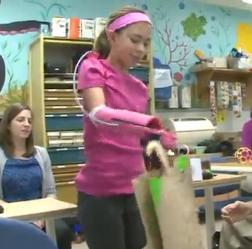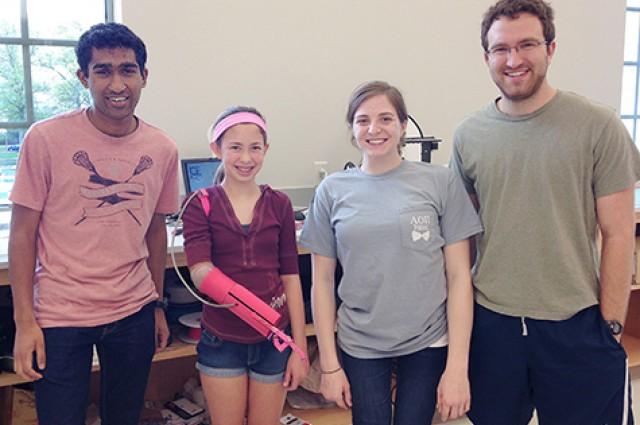The changes that 3D printing are bringing to the prosthetic market are incredible. In just the last one or two years we have seen so many amazing stories pertaining to the 3D printing of prosthetic limbs, that it’s almost impossible not to get excited.
Just recently, a few ‘Washington University in St. Louis’ students decided to help a 13 year old girl who was missing her right arm, due to a boating accident seven years ago. Sydney Kendall, the recipient of the arm, had just  one, rather simple request for the three seniors, all studying biomedical engineering. The request was to make it pink.
one, rather simple request for the three seniors, all studying biomedical engineering. The request was to make it pink.
Using CAD software and a 3D printer, the three students, Kendall Gretsch, Henry Lather and Kranti Peddada set out to provide Sydney with that pink arm she had requested, and so much more. Because of their lack of experience around prosthetics, they sought advice from several experts in the field, which included both Charles A. Goldfarb and Lindley Wall, who are orthopedic hand surgeons. Together the team developed a hand that was not only pink, but one which featured a working thumb as well as a motor. By moving the shoulder upwards, the user can open all five finger, and while moving the shoulder down to a normal position, the fingers all flex to grip something. Horizontal movement of the shoulder will flex and extend the thumb alone. This sets it apart from the Robohand models which have frequently received media attention in the past. The device allows Sydney to do much that she had missed out on for the past seven years, such as throwing a ball, and using a computer mouse.
“It really showed us the great things you can accomplish when you bridge medicine and technology,” Peddada said.
In all, the cost of materials for the hand were approximately $200. This is a far cry from the $6,000 or more that a typical prosthetic device would cost. Many times children will forego prosthetics, simply because of the high prices, and the need to constantly purchase new devices as they grow and develop. The great thing about these 3D printed prosthetics are that the design can quickly be manipulated on a computer, and printed out to fit a growing child, for only a couple hundred bucks.
All three students received credit for the creation of this device, as it was a part of their engineering design course, which they were taking with Joseph Klaesner, PhD, Associate Professor of Physical Therapy at the School of Medicine. Feel free to head over to the 3D printed electronic arm thread on 3DPB.com to discuss issues related to these types of devices. Also if you are looking to have a prosthetic 3D printed for yourself, be sure to make a post in the ‘Need a Prosthetic 3D Printed’ folder on 3DPB.com.

